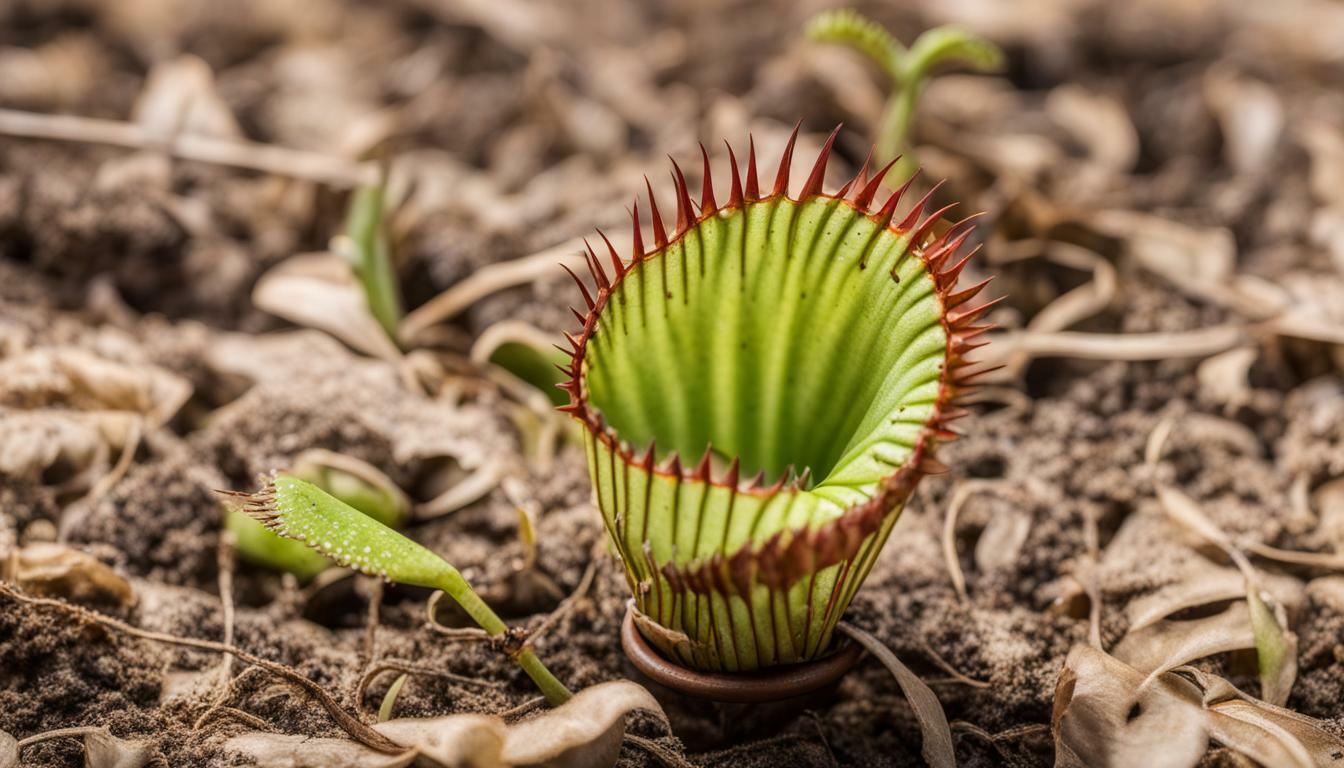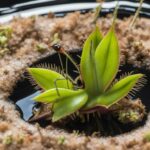Venus Flytraps are intriguing carnivorous plants that require proper care to thrive. One question that often arises for Venus Flytrap owners is whether or not pruning is necessary for their care. Understanding the natural growth habits of Venus Flytraps and the benefits of pruning can help you provide the best care for your plant.
While Venus Flytraps are relatively low-maintenance plants, pruning can help promote optimal growth and overall health. By removing dead leaves and traps, you can prevent disease and pest infestations while promoting new growth. However, it’s important to know when and how to prune your Venus Flytrap for maximum effectiveness.
Key Takeaways
- Venus Flytraps can benefit from pruning for optimal growth and health.
- Understanding the timing and techniques for pruning can help prevent disease and pest infestations while promoting new growth.
When to Prune Venus Flytraps: Timing is Key
Pruning Venus Flytraps at the right time is critical for their overall health and growth. As with most plants, there are specific seasons and growth stages that are best for pruning.
The optimal time to prune Venus Flytraps is during their active growing season, which typically runs from late spring to early fall. Pruning during this period encourages the plant to produce new growth and can help shape the plant’s overall appearance.
It is essential to avoid any pruning during their dormant period in winter. Pruning during this time can damage the plant and stunt its growth, making it more susceptible to disease.
Similarly, avoid pruning during the Venus Flytrap’s flowering period in late spring. Pruning during this period can affect the plant’s ability to produce flowers and reduce the overall plant’s health and vitality.
How to Prune Venus Flytraps: A Step-by-Step Guide
Pruning Venus Flytraps may seem intimidating, but it’s a simple process that can greatly benefit the plant’s growth and health. Here’s a step-by-step guide to pruning your Venus Flytrap:
- First, gather your tools. You’ll need a pair of small, sharp scissors or pruning shears and rubbing alcohol to sterilize the blades.
- Identify the older, dying trap leaves on the plant. These leaves will turn black and will not be able to catch insects anymore.
- Using your scissors or pruning shears, carefully trim the old, black leaves from the plant at the base of the leaf stem. Be sure to leave the new, healthy leaves intact.
- Once you’ve removed all of the old, black leaves, assess the plant’s condition. If any of the healthy leaves have become damaged or discolored, you can trim these as well.
- Finally, sterilize your pruning tools with rubbing alcohol to prevent the spread of disease or pests to your plant.
It’s important to note that Venus Flytraps do not require pruning as often as other plants, and excessive pruning can actually harm their growth. Only prune when necessary to remove old or damaged leaves.
Additionally, avoid pruning your Venus Flytrap during its winter dormancy period. Wait until the plant has begun to actively grow again in the spring before pruning.
By following these steps and being mindful of your plant’s growth habits, you can prune your Venus Flytrap effectively and promote healthy new growth.
Pruning Venus Flytraps for Optimal Growth: Tips and Tricks
Pruning Venus Flytraps is essential for keeping them healthy and thriving. Here are some tips to help you maintain your Venus Flytrap:
- Prune dead traps: Trim any dead or blackened traps to prevent disease from spreading to the healthy parts of the plant.
- Cut back in Spring: Prune your Venus Flytrap in the spring to encourage new growth and traps to form.
- Trim flower stalks: Venus Flytraps produce flower stalks in the spring. It’s best to trim these off, as they can drain energy from the plant and reduce the number of traps it produces.
- Avoid trimming healthy traps: Venus Flytraps need their traps to capture their prey. Only prune traps that have died or turned black, as mentioned above.
Proper maintenance can also contribute to the health of your Venus Flytrap:
- Provide adequate lighting: Venus Flytraps need bright, direct sunlight to thrive. Make sure they receive at least 4-6 hours of direct sunlight each day.
- Keep the soil moist: Venus Flytraps grow best in moist soil. Avoid letting the soil dry out, as this can harm the plant.
- Use distilled water: Tap water can contain minerals and other chemicals that can harm your Venus Flytrap. Use distilled water or rainwater instead.
- Avoid fertilizers: Venus Flytraps obtain their nutrients from their prey, so they do not require fertilizer.
By following these pruning and maintenance tips, your Venus Flytrap will remain healthy and vibrant, providing a fascinating addition to your indoor or outdoor garden.
Conclusion: Enhancing Venus Flytrap Care Through Pruning
In conclusion, pruning is an essential aspect of Venus Flytrap care that can lead to optimal growth and longevity. Regular pruning helps keep the plant’s traps healthy, promotes new growth, and prevents diseases and pest infestations. By cutting back dead or dying leaves, traps, and flowers, you allow the plant to redirect its energy to new growth where it’s needed most. Remember, Venus Flytraps are unique plants that have adapted to thrive in nutrient-poor soils by relying on insects for survival. For this reason, it’s essential to keep them healthy and happy through proper pruning techniques. By doing so, you’ll be rewarded with a fascinating and beautiful plant that will continue to captivate you for years to come. So why wait? Start pruning your Venus Flytrap today and witness the magic of optimal growth and health for yourself. Happy pruning! SEO Keywords: reasons for pruning venus flytraps.What Are the Common Mistakes to Avoid When Pruning a Venus Flytrap?
When pruning a Venus Flytrap, it is crucial to avoid certain common venus flytrap care mistakes. One mistake is trimming off healthy leaves, which are vital for the plant’s photosynthesis. Another mistake is over-pruning, as it can weaken the plant and inhibit its growth. Additionally, avoid cutting the traps too close to the base, as it may harm the plant’s regrowth abilities. Diligently avoiding these venus flytrap care mistakes ensures a healthy and thriving plant.
FAQ
Q: Do Venus Flytraps require pruning?
A: Yes, Venus Flytraps can benefit from pruning to promote optimal growth and health.
Q: When is the best time to prune Venus Flytraps?
A: It is best to prune Venus Flytraps during their active growing season, typically in the spring or early summer.
Q: How do I prune Venus Flytraps?
A: To prune Venus Flytraps, carefully trim away any dead or dying leaves or traps using sharp, sterile scissors or pruning shears.
Q: What areas of the plant should I focus on when pruning Venus Flytraps?
A: When pruning Venus Flytraps, focus on removing any dead or dying leaves, traps, or stems to encourage new growth and maintain the overall health of the plant.
Q: Can pruning Venus Flytraps promote new growth?
A: Yes, pruning Venus Flytraps can help stimulate new growth and encourage the production of healthy traps.
Q: Are there any specific techniques or tips for pruning Venus Flytraps?
A: When pruning Venus Flytraps, make sure to use clean, sharp tools, and avoid over-pruning or damaging the remaining healthy traps or leaves.
Q: Will pruning prevent disease or pest infestations in Venus Flytraps?
A: Proper pruning techniques can help prevent disease or pest infestations in Venus Flytraps by removing potential breeding grounds for pests and improving overall plant health.
Q: Why is pruning important for Venus Flytrap care?
A: Pruning is important for Venus Flytrap care because it helps maintain the plant’s overall health, promotes new growth, and ensures the vitality and longevity of the traps.










